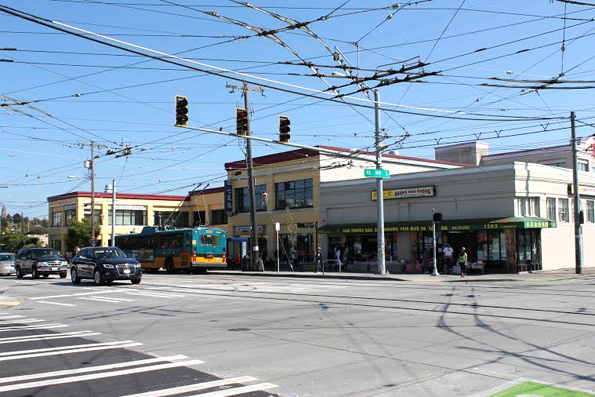By James Tabafunda
Northwest Asian Weekly

Intersection of 12th Avenue South and South Jackson Street in Little Saigon
Seattle’s Little Saigon neighborhood has reinvented itself several times over the last 100 years. It was not always the go-to spot for authentic Southeast Asian food or the social and economic center of the Vietnamese American community.
Located at the easternmost part of the International District, it is bordered by South Main Street to the north, Rainier Avenue South to the east, South Dearborn Street to the south, and Interstate 5 to the west.
Like many of the city’s other neighborhoods, its first transformation took place when Seattle’s first residents and developers raised and lowered the levels of city land, known as “regrading.” It became a part of the Jackson Street regrade in 1909.
Long before it was called Little Saigon, this neighborhood’s first occupants were Jewish and African American.
Little Saigon’s current center – 12th Avenue South and South Jackson Street – used to be the location of one of the city’s many jazz clubs. Entrepreneurs Russell “Noodles” Smith and Jimmy Woodland opened the Entertainers Club at this intersection in 1920.
At that time, South Jackson Street also became a social hotspot for Filipino, Chinese, and Japanese residents.
World War II changed the neighborhood as more African Americans moved in, as defense jobs became available.
Instead of defense jobs, Japanese residents received orders to move to relocation camps under President Franklin Roosevelt’s Executive Order 9066 in 1942.
Little Saigon underwent another major renovation in the early 1960s. The state of Washington built Interstate 5, creating Little Saigon’s western boundary.
Over the next few decades, Seattle city planners and real estate developers transformed the neighborhood once again, adding such suburban features as large block sizes and strip malls to replace Little Saigon’s once popular jazz clubs.
By the end of 1975, 2,000 Vietnamese lived in Seattle after the fall of Saigon on April 30th of that year. According to the 2010 census, almost 12,000 people now live in the city.
They were joined by immigrants from Cambodia, Laos, and other areas of Southeast Asia. The second wave of Vietnamese, Cambodian, and Laotian refugees took place in 1978.
Little Saigon earned its nickname in 1984 when Southeast Asian merchants created their own commercial center east of the International District. Three years later, the third wave of Vietnamese immigrants, refugees, and Amerasian children took place.
Born and raised in Vietnam until the age of 8, Theresa Reyna once worked in Little Saigon and is now the vice president of Friends of Little Saigon, an organization created to promote the neighborhood’s economic development and cultural activities.
Her family opened its jewelry store – Kim Ngoc – in Little Saigon in 1986, becoming the second such business in the neighborhood’s early days. There were challenges along the way, but she says the economy eventually prospered and the neighborhood had 14 jewelry stores in 2000, all within walking distance of each other.
She worked as a sales associate for her family business, but now runs her own language-service agency, Interpret This, Inc., in Bellevue.
Reyna says there was cooperation among Vietnamese business owners in Little Saigon in the 1980s. “They were able to grow together. We had that sense of community,” she added.
Over time, customers would come from far away for not only jewelry, but also authentic Southeast Asian food, foot massages, and even affordable haircuts at Little Saigon’s beauty school.
She said, “People knew us and had come as far as Pasco, Wash. to just drive up for the day to shop with us.”
Diversity is one of Little Saigon’s strengths with a Taiwanese restaurant now open. It will also be featured at the Celebrate Little Saigon festival on Aug. 24, which highlights the three regional cultures of Vietnam.
“We love the diversity in this community,” Reyna said.
For more information about the Celebrate Little Saigon Annual Summer Festival, go to http://friendsoflittlesaigon.org/fls-events/celebrate-little-saigon/. For more information about Interpret This, Inc., go to www.interpretthisinc.com.
James Tabafunda can be reached at info@nwasianweekly.com.

